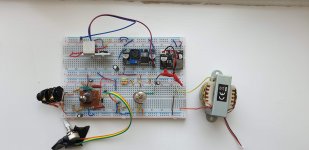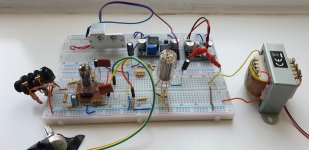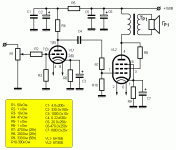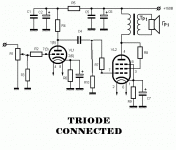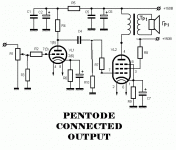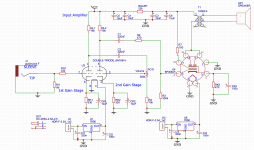Actually, I knew about those because once, when I was googling, I came across this webpage.
RuSubMin-Tubes
It has a nice summary and data sheets of the most common subminiature Russian tubes for guitar amplifiers.
So, would it be better to go for the combination 6N17B + 6N30B (pre + power) or 6N16B + 6N30B?
Cheers,
Pedro
6N16B and 6p30B-R is better. But the single triode versions are better still (than 6N16B), and easier to use.
6N17B is higher mu and pretty gutless, like 12ax7, and has higher THD than the 6N16B
Sort of echoing what Sarcastic mentioned:
I used them 3x parallel 6P30BR SEP, with the g2 voltage set to 230V and B+ of 320V, for 3W single ended output power
Often the characteristics of these valves are more than 100% tolerance. They are getter less, and can be prone to runaway, due to gas.
Keep them under 5W Pd and they will not red plate.
Go above 15mA (or 5W Pd) and one of the dual plates will begin to glow.
That is their worst failing. They SHOULD kick out almost 19mA at the same dissipation, but don't, because of the unmatched nature of the dual anodes.
But they're probably far better suited to PP as Sarcastic suggested.
Last edited:
There are plenty of reliable vendors in the UKR, and Russia.
Avoid Romanian sellers, who offload the rubbish.
Sovtube is reliable for example.
So far, I have not had one bad valve from the Ukraine or Russia.
YMMV
Avoid Romanian sellers, who offload the rubbish.
Sovtube is reliable for example.
So far, I have not had one bad valve from the Ukraine or Russia.
YMMV
Hi,
Thanks for the info.
I bought the tubes, on eBay, from a guy from Ukraine and they came very well packed and protected.
I ended up buying 6N16B and 6P30B-R. I hope they are good.
I am not aiming to do a 5W amp, 1W would be enough. So I think I can get away with lower voltages and even in class
My idea is to use a double triode (6N16B) for 2 preamp stages and the 6P30B-R for the power stage. A. Let's see.
Cheers,
Pedro
Thanks for the info.
I bought the tubes, on eBay, from a guy from Ukraine and they came very well packed and protected.
I ended up buying 6N16B and 6P30B-R. I hope they are good.
I am not aiming to do a 5W amp, 1W would be enough. So I think I can get away with lower voltages and even in class
My idea is to use a double triode (6N16B) for 2 preamp stages and the 6P30B-R for the power stage. A. Let's see.
Cheers,
Pedro
My advice, go PPP forget SE. 6P30B-R
Load a quad of them as parallel push pull, treat them as 6v6, you can even get away with Cathode bias if you insist.
they will give you an easy 12w-15w that way into a 6.6k load with lower thd
Load a quad of them as parallel push pull, treat them as 6v6, you can even get away with Cathode bias if you insist.
they will give you an easy 12w-15w that way into a 6.6k load with lower thd
I agree that they will make much more power in PP AB1 or something of the sort.
Even one PP pair would make good power, though a Parallel pair is needed to approach a 6V6 (or 6P6S).
People like the 12AQ5, 6P1P tube. I dont. The 6P6S is much better.
Even one PP pair would make good power, though a Parallel pair is needed to approach a 6V6 (or 6P6S).
People like the 12AQ5, 6P1P tube. I dont. The 6P6S is much better.
As far as the preamplifcation stages, 2 stages of 6N16B will be sufficient in gain to allow some local feedback if desired.
One gain stage may be all you need, if a no feedback design is what you want.
2 stages of 6N16B has good THD, when compared to a 6N17B gain stage, partially due to cancellation but also due to the inherent nature of medium MU triodes.
One gain stage may be all you need, if a no feedback design is what you want.
2 stages of 6N16B has good THD, when compared to a 6N17B gain stage, partially due to cancellation but also due to the inherent nature of medium MU triodes.
Hi guys,
I have some doubts regarding the design of the amplifier (I am using LTSpice for this).
I am assuming a max input swing of the input of +/-2V. That will give me something around 70V or so at the output. I am assuming that I cannot feed 70V to the grid of the next valve.
I will use a bypass capacitor between 1st and 2nd stages, but then, what voltages levels are acceptable to apply to the grid?
I think, I will go for center biasing in both tubes.
Best regards,
Pedro
I have some doubts regarding the design of the amplifier (I am using LTSpice for this).
I am assuming a max input swing of the input of +/-2V. That will give me something around 70V or so at the output. I am assuming that I cannot feed 70V to the grid of the next valve.
I will use a bypass capacitor between 1st and 2nd stages, but then, what voltages levels are acceptable to apply to the grid?
I think, I will go for center biasing in both tubes.
Best regards,
Pedro
Hi,
I have the amp working on a breadboard.
Using just one 6N16B, the sound is crystal clear. Sweet !!
However, when I connect the 6P30B-R, it picks-up all the electromagnetic noise around and generates a huge hiss, making playing impossible.
I am using a buck to generate the 6.3V and a boost to generate 180V. I know that this will generate lots of switching noise...
When I cover the volume pot with my hand, the noise goes a bit down.So, it looks to me, that I have antenas everywhere.
Any ideas?
Cheers,
Pedro
I have the amp working on a breadboard.
Using just one 6N16B, the sound is crystal clear. Sweet !!
However, when I connect the 6P30B-R, it picks-up all the electromagnetic noise around and generates a huge hiss, making playing impossible.
I am using a buck to generate the 6.3V and a boost to generate 180V. I know that this will generate lots of switching noise...
When I cover the volume pot with my hand, the noise goes a bit down.So, it looks to me, that I have antenas everywhere.
Any ideas?
Cheers,
Pedro
when mounted in a metal case that will provide shielding
otherwise a open circuit on breadboard
is susceptible to noise.
Otherwise without writing a whole book in a comment.
With tube circuits. " Lead Dress" is important.
As far as basic wire routing to high voltage pins/ heater/ small signal
shielded wire also helps for small signal routing
and how/where you terminate the ground shield
otherwise a open circuit on breadboard
is susceptible to noise.
Otherwise without writing a whole book in a comment.
With tube circuits. " Lead Dress" is important.
As far as basic wire routing to high voltage pins/ heater/ small signal
shielded wire also helps for small signal routing
and how/where you terminate the ground shield
Last edited:
Thanks for your answer.
Is it important to have separate grounds for power and signal?
I have all of them connected together.
Is it important to have separate grounds for power and signal?
I have all of them connected together.
Last edited:
1,
Do you have a capacitor in parallel to the grid leak resistor to help reject RF? On one stage? On all stages?
2,
The screen supply of the 6P30B-R is very important, as any other pentode, or beam tube.
6P30B-R Vg2 in my experiments is supplied by 230VDC, zener regulated, from the main HT supply.
The Zener is stabilised with 1000uF 75V capacitor bypassing to earth.
I had some white noise and a little RF ingress but it is mostly dealt with using the 2 measures above.
Do you have a capacitor in parallel to the grid leak resistor to help reject RF? On one stage? On all stages?
2,
The screen supply of the 6P30B-R is very important, as any other pentode, or beam tube.
6P30B-R Vg2 in my experiments is supplied by 230VDC, zener regulated, from the main HT supply.
The Zener is stabilised with 1000uF 75V capacitor bypassing to earth.
I had some white noise and a little RF ingress but it is mostly dealt with using the 2 measures above.
Hi,
Thanks for your reply.
Regarding 1, I don't have a cap in parallel with the input leak resistor. Which type of cap would you advise and value please? (eg. electrolytic 10uF or so)
In what concerns point 2, I confess I don't have a cap there as you are suggesting.
I will add these caps to the circuit and let you know the outcome.
Please take at look at my circuit attached, maybe you will identify something else. The circuit looks a bit messy... 😀
Cheers,
Pedro
Thanks for your reply.
Regarding 1, I don't have a cap in parallel with the input leak resistor. Which type of cap would you advise and value please? (eg. electrolytic 10uF or so)
In what concerns point 2, I confess I don't have a cap there as you are suggesting.
I will add these caps to the circuit and let you know the outcome.
Please take at look at my circuit attached, maybe you will identify something else. The circuit looks a bit messy... 😀
Cheers,
Pedro
Attachments
1,
The value of the C is determined based on the value of the grid leak resistor. You can calculate, or try something like 100pF mica
2,
For screen voltage regulation, with a zener diode string, I would use something like 100uF 400V electrolytic
However, I have used some DCDC supplies which were noisy regardless, and the only thing that reduced the induced noise, was distance.
EDIT and CORRECTION to post 51:
My screen supply is zener regulated to 230V, using 1N53** 5W zener diodes, and is bypassed with a 100uF or 220uF 400V electrolytic (apologies for the typo)
The value of the C is determined based on the value of the grid leak resistor. You can calculate, or try something like 100pF mica
2,
For screen voltage regulation, with a zener diode string, I would use something like 100uF 400V electrolytic
However, I have used some DCDC supplies which were noisy regardless, and the only thing that reduced the induced noise, was distance.
EDIT and CORRECTION to post 51:
My screen supply is zener regulated to 230V, using 1N53** 5W zener diodes, and is bypassed with a 100uF or 220uF 400V electrolytic (apologies for the typo)
Last edited:
Ok, so you are triode wiring the 6P30BR.
In that case, no bypass is required, as you aren't running in pentode or beam power tube mode.
But a single device will make perhaps 0.75W in triode single ended, is this enough?
(runs to recheck the application)
Yes mini guitar amp...should be OK for quiet practice.
I think the DIYA user Wavebourn has made a small amplifier using these Subminiature valves too, maybe his threads are worth searching?
I have used them for a SET hifi amplifier, 3 in parallel for about 3 Watts.
In that case, no bypass is required, as you aren't running in pentode or beam power tube mode.
But a single device will make perhaps 0.75W in triode single ended, is this enough?
(runs to recheck the application)
Yes mini guitar amp...should be OK for quiet practice.
I think the DIYA user Wavebourn has made a small amplifier using these Subminiature valves too, maybe his threads are worth searching?
I have used them for a SET hifi amplifier, 3 in parallel for about 3 Watts.
Last edited:
If you are using that schematic, then perhaps try something like 220pF Mica capacitor in parallel with R10 at the grid of the 6P30BR, that may help your RF pickup.
If I am honest I don't like the low input impedance of the front end, grid resistor of only 10k!
Most guitar pickups are about 5k to 9k, if I recall correctly, and I would have believed a guitar needed a higher impedance load to drive (the input of the amp) but I am by no means an expert!
If I am honest I don't like the low input impedance of the front end, grid resistor of only 10k!
Most guitar pickups are about 5k to 9k, if I recall correctly, and I would have believed a guitar needed a higher impedance load to drive (the input of the amp) but I am by no means an expert!
The leak resistor I use is not 10k, is 1Meg. I found that one too small to.
How can I connect this valve differently, so it works as a pentode/tetrode?
How can I connect this valve differently, so it works as a pentode/tetrode?
Hi,
when I connect the 6P30B-R, it picks-up all the electromagnetic noise around and generates a huge hiss, making playing impossible.
It's oscillating.
Put a 22-47 ohm into the anode lead and/or a small choke.
It's quite a common problem.
also run a DC heater and wrap the triode in silver (cooking) foil - earthed or you will get loads of hum.
Yes, parasitic (unwanted) oscillation is a likely cause for your hiss and noises.
R2 and R7 are not connected in the right place. As is they cannot work as "grid stoppers" and therefore cannot suppress oszillation.
R2 and R7 should be connected *directly* to the grid terminals as indicated in attachment #1.
And directly means as short as possible. Your tubes have wires which necessitates to cut the grid wire about a centimeter from the glass and solder R2 and R7 right there a cm from the glass.
Do the same with screen resistor R8.
To wire the output tube as pentode you can connect the screen grid G2 resistor R8 directly to the power supply 150V as indicated in attachment #2.
R2 and R7 are not connected in the right place. As is they cannot work as "grid stoppers" and therefore cannot suppress oszillation.
R2 and R7 should be connected *directly* to the grid terminals as indicated in attachment #1.
And directly means as short as possible. Your tubes have wires which necessitates to cut the grid wire about a centimeter from the glass and solder R2 and R7 right there a cm from the glass.
Do the same with screen resistor R8.
To wire the output tube as pentode you can connect the screen grid G2 resistor R8 directly to the power supply 150V as indicated in attachment #2.
Attachments
Last edited:
@sarcastic1 Ok, I will try putting that resistor there and will let you know the outcome. 🙂
@Sorento By the way, my circuit is not the one that I've posted. That was just an example to check the pentode's connection.
My circuit is the one attached. Most probably you'll find some problems on mine too. 🙂
Actually, there is something I have, already ,to change from your comments on the previous circuit.
Really appreciate your help. This is my first circuit and I have to learn a lot.
@Sorento By the way, my circuit is not the one that I've posted. That was just an example to check the pentode's connection.
My circuit is the one attached. Most probably you'll find some problems on mine too. 🙂
Actually, there is something I have, already ,to change from your comments on the previous circuit.
Really appreciate your help. This is my first circuit and I have to learn a lot.
Attachments
Last edited:
- Home
- Amplifiers
- Tubes / Valves
- Subminiature tubes Spice models
